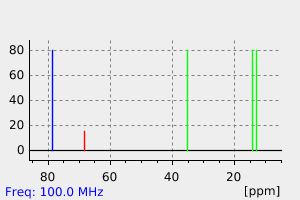5-bromospiro(1-pyrazoline-3,1'-cyclopropane) | 211738-70-4
中文名称
——
中文别名
——
英文名称
5-bromospiro(1-pyrazoline-3,1'-cyclopropane)
英文别名
6-Bromo-4,5-diazaspiro[2.4]hept-4-ene
CAS
211738-70-4
化学式
C5H7BrN2
mdl
——
分子量
175.028
InChiKey
WDOMXUHCDWZKKX-UHFFFAOYSA-N
BEILSTEIN
——
EINECS
——
-
物化性质
-
计算性质
-
ADMET
-
安全信息
-
SDS
-
制备方法与用途
-
上下游信息
-
文献信息
-
表征谱图
-
同类化合物
-
相关功能分类
-
相关结构分类
物化性质
-
沸点:188.6±29.0 °C(Predicted)
-
密度:2.10±0.1 g/cm3(Predicted)
计算性质
-
辛醇/水分配系数(LogP):1.6
-
重原子数:8
-
可旋转键数:0
-
环数:2.0
-
sp3杂化的碳原子比例:1.0
-
拓扑面积:24.7
-
氢给体数:0
-
氢受体数:2
反应信息
-
作为反应物:描述:5-bromospiro(1-pyrazoline-3,1'-cyclopropane) 在 sodium azide 作用下, 以 二氯甲烷 、 水 、 丙酮 为溶剂, 反应 3.0h, 生成 Z-N-{3-azidospiro[1-pyrazolinio-5,1'-cyclopropane]}-N-phthalimidoamide参考文献:名称:Different reactivities of regioisomeric azimines, adducts of phthalimidonitrene with 5-bromospiro[1-pyrazoline-3,1′-cyclopropane]摘要:The addition of the phthalimidonitrene fragment. resulting from oxidation of N-aminophthalimide by lead tetraacetate at -20 to -30 degreesC, to the N=N-bond of 5-bromospiro[1-pyrazoline-3,1'-cyclopropane] (1) affords, apart from the stable 5-bromoN-(spiro[1-pyrazolinio-3,1-cyclopropane])-N-phthalimidoamide (azimine 2), regioisomeric azimine 3, which is completely transformed into 3-acetoxy-N-(spiro[1-pyrazolinio-5,1'-cyclopropane])- N-phthalimidoamide (4) under the reaction conditions. The acetoxy group in this product easily. undergoes nucleophilic substitution on treatment with MeOH. NaN3. or the starting bromopyrazoline 1. The structures of azimines obtained were established using N M R spectra. and the structure of the product of reaction of 4 with 1 was additionally proved by X-ray difraction data.DOI:10.1007/bf02494938
-
作为产物:描述:溴乙烯 、 1-环丙基-1-亚硝基脲 在 sodium methylate 作用下, 以 甲醇 、 二氯甲烷 为溶剂, 反应 0.17h, 生成 5-bromospiro(1-pyrazoline-3,1'-cyclopropane)参考文献:名称:Addition of diazocyclopropane generatedin situ to vinyl bromide and chemical transformations of the resulting 5-bromospiro(1-pyrazoline-3,1′-cyclopropane)摘要:The reaction of diazocyclopropane generated in situ with vinyl bromide occurs as regioselective 1,3-dipolar cycloaddition to give 5-bromospiro(1-pyrazoline-3,1'-cyclopropane) in similar to 60% yield. Reactions of the latter with nucleophilic reagents, which can occur both with retention and opening of the cyclopropane ring, were studied.DOI:10.1007/bf02495975
文献信息
-
Reactions of spirocyclopropane-containing 1- and 2-pyrazolines with electrophilic reagents作者:Yu. V. Tomilov、I. V. Kostyuchenko、G. P. Okonnishnikova、E. V. Shulishov、E. A. Yagodkin、O. M. NefedovDOI:10.1007/bf02494777日期:2000.3Hydrochlorination of spiro(1-pyrazoline-3,1′-cyclopropanes) proceeds regioselectively at the azocyclopropane group to form 3-(2-haloethyl)pyrazoline derivatives. If the latter contain a halogen atom in the heterocycle, they are readily converted into (2-haloethyl)pyrazole hydrohalides. Bromination of 3-cyanospiro(2-pyrazoline-5,1′-cyclopropane) withN-bromosuccinimide at 20°C proceeds with retention
-
Formation and thermal decomposition of adducts of phthalimidonitrene with spiro(1-pyrazolinecyclopropanes)作者:Yu. V. Tomilov、I. V. Kostyuchenko、E. V. Shulishov、B. B. Averkiev、M. Yu. Antipin、O. M. NefedovDOI:10.1007/bf02495296日期:1999.7large extent by the nature of the substituents in the pyrazoline ring. The structures of phthalimidoazimines were established based on the NMR spectra and X-ray diffraction data. Thermal conversions of the resulting adducts, which proceeded either with retention or with opening of the spiro-fused cyclopropane ring, were studied.
表征谱图
-
氢谱1HNMR
-
质谱MS
-
碳谱13CNMR
-
红外IR
-
拉曼Raman
-
峰位数据
-
峰位匹配
-
表征信息
同类化合物
(乙腈)二氯镍(II)
(R)-(-)-α-甲基组胺二氢溴化物
(N-(2-甲基丙-2-烯-1-基)乙烷-1,2-二胺)
(4-(苄氧基)-2-(哌啶-1-基)吡啶咪丁-5-基)硼酸
(11-巯基十一烷基)-,,-三甲基溴化铵
鼠立死
鹿花菌素
鲸蜡醇硫酸酯DEA盐
鲸蜡硬脂基二甲基氯化铵
鲸蜡基胺氢氟酸盐
鲸蜡基二甲胺盐酸盐
高苯丙氨醇
高箱鲀毒素
高氯酸5-(二甲氨基)-1-({(E)-[4-(二甲氨基)苯基]甲亚基}氨基)-2-甲基吡啶正离子
高氯酸2-氯-1-({(E)-[4-(二甲氨基)苯基]甲亚基}氨基)-6-甲基吡啶正离子
高氯酸2-(丙烯酰基氧基)-N,N,N-三甲基乙铵
马诺地尔
马来酸氢十八烷酯
马来酸噻吗洛尔EP杂质C
马来酸噻吗洛尔
马来酸倍他司汀
顺式环己烷-1,3-二胺盐酸盐
顺式氯化锆二乙腈
顺式吡咯烷-3,4-二醇盐酸盐
顺式双(3-甲氧基丙腈)二氯铂(II)
顺式3,4-二氟吡咯烷盐酸盐
顺式1-甲基环丙烷1,2-二腈
顺式-二氯-反式-二乙酸-氨-环己胺合铂
顺式-二抗坏血酸(外消旋-1,2-二氨基环己烷)铂(II)水合物
顺式-N,2-二甲基环己胺
顺式-4-甲氧基-环己胺盐酸盐
顺式-4-环己烯-1.2-二胺
顺式-4-氨基-2,2,2-三氟乙酸环己酯
顺式-3-氨基环丁烷甲腈盐酸盐
顺式-2-羟基甲基-1-甲基-1-环己胺
顺式-2-甲基环己胺
顺式-2-(苯基氨基)环己醇
顺式-2-(苯基氨基)环己醇
顺式-2-(氨基甲基)-1-苯基环丙烷羧酸盐酸盐
顺式-1,3-二氨基环戊烷
顺式-1,2-环戊烷二胺二盐酸盐
顺式-1,2-环戊烷二胺
顺式-1,2-环丁腈
顺式-1,2-双氨甲基环己烷
顺式--N,N'-二甲基-1,2-环己二胺
顺式-(R,S)-1,2-二氨基环己烷铂硫酸盐
顺式-(2-氨基-环戊基)-甲醇
顺-2-戊烯腈
顺-1,3-环己烷二胺
顺-1,3-双(氨甲基)环己烷







